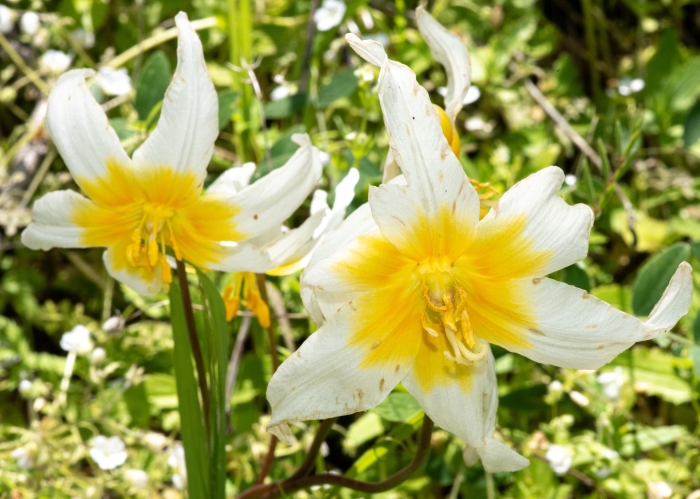Pacific Fawn Lily
(Erythronium helenae)
Pacific Fawn Lily (Erythronium helenae)
/
/

Don Loarie
CC BY 4.0
Image By:
Don Loarie
Recorded By:
Copyright:
CC BY 4.0
Copyright Notice:
Photo by: Don Loarie | License Type: CC BY 4.0 | License URL: http://creativecommons.org/licenses/by/4.0/ | Rights Holder: Don Loarie | Publisher: iNaturalist | Date Created: 2022-04-26T13:39:40-07:00 |
























Estimated Native Range
Summary
Erythronium helenae, commonly known as Pacific fawn lily or St. Helena fawn lily, is a perennial herb endemic to the coastal mountains north of the San Francisco Bay Area in California, particularly in moist, shaded woodlands and grasslands. It is often found at elevations of 1,640 to 3,937 feet, typically on serpentine soils, which are known for their low fertility and high levels of heavy metals. The plant features wide, mottled leaves that resemble the pattern of a fawn’s coat, and it produces erect stalks up to 12 inches tall. Each stalk bears 1-3 nodding flowers with white tepals that have yellowish bases, blooming in early spring. The flowers are quite showy and attract pollinators such as bees.
Pacific fawn lily is appreciated for its ornamental value, particularly its distinctive mottled foliage and delicate flowers. It is suitable for woodland gardens, rock gardens, and native plant landscapes, where it can be used as an understory plant. It requires well-drained soil, consistent moisture, and partial to full shade, mimicking its natural woodland habitat. While it is not commonly found in cultivation due to its specific growing requirements, it can be a rewarding plant for those who can replicate its native conditions. Care should be taken to avoid overwatering and to provide protection from strong afternoon sun.CC BY-SA 4.0
Pacific fawn lily is appreciated for its ornamental value, particularly its distinctive mottled foliage and delicate flowers. It is suitable for woodland gardens, rock gardens, and native plant landscapes, where it can be used as an understory plant. It requires well-drained soil, consistent moisture, and partial to full shade, mimicking its natural woodland habitat. While it is not commonly found in cultivation due to its specific growing requirements, it can be a rewarding plant for those who can replicate its native conditions. Care should be taken to avoid overwatering and to provide protection from strong afternoon sun.CC BY-SA 4.0
Plant Description
- Plant Type: Herb, Bulb
- Height: 0.5-1 feet
- Width: 0.5-1 feet
- Growth Rate: Moderate
- Flower Color: White, Yellow
- Flowering Season: Spring
- Leaf Retention: Deciduous
Growth Requirements
- Sun: Part Shade
- Water: Medium
- Drainage: Medium
Common Uses
Bee Garden, Border Plant, Butterfly Garden, Low Maintenance
Natural Habitat
Moist, shaded woodlands and grasslands on serpentine soils within the coastal mountains north of the San Francisco Bay Area
Other Names
Common Names: St. Helena Fawn Lily, Helena Fawnlily
Scientific Names: , Erythronium helenae,
GBIF Accepted Name: